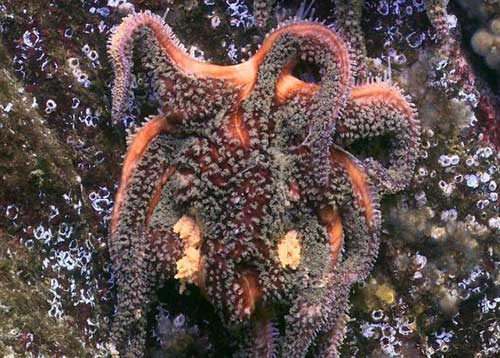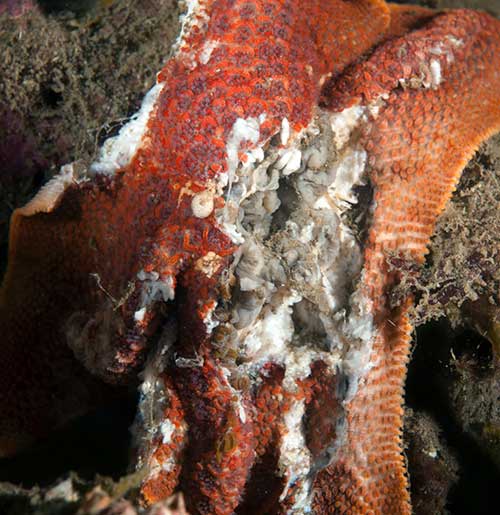
Top Suspect in Devastating Sea Star Wasting Disease IdentifiedVirus' extensive geographic range and number of species infected might make it largest known marine wildlife disease to date
November 17, 2014
In Southeast Alaska, the Sitka Sound Science Center staff along with biologists from University of Alaska Southeast in Sitka have also identified an outbreak of sea star wasting disease in Sitka Sound. Tissue samples from sea stars taken from Sitka’s long-term sites are currently being analyzed at Cornell University.
Pictured is a SSWD-affected star. The fatal disease leads to behavioral changes, lesions, loss of appendages, and disintegration. Now, a researcher in the College of Agriculture and Life Sciences at Cornell University has identified the deadly culprit as the Sea Star Associated Densovirus (SSaDV), a type of parvovirus commonly found in invertebrates. In a study published Nov. 17 in the Proceedings of the National Academy of Sciences, microbiologist Hewson and colleagues present a genomic analysis of the newly discovered virus prevalent in symptomatic sea stars. "There are 10 million viruses in a drop of seawater, so discovering the virus associated with a marine disease can be like looking for a needle in a haystack," says lead author Ian Hewson, a professor of microbiology. "Not only is this an important discovery of a virus involved in a mass mortality of marine invertebrates, but this is also the first virus described in a sea star." The discovery will enable scientists to study how the virus infects sea stars and trace it in the ocean. Further research could reveal how the virus invades its host, why kills some sea stars, and why other species are unaffected. Hewson suggests that the virus has been smoldering at a low level for many years. It was present in museum samples of sea stars collected in 1942, 1980, 1987 and 1991, and may have risen to epidemic levels in the last few years due to sea star overpopulation, environmental changes, or mutation of the virus. Sea water, plankton, sediments and water filters from public aquariums, sea urchins and brittle stars also harbored the virus. The research lays the groundwork for understanding how the virus kills sea stars and what triggers outbreaks. The stakes are high, according to Drew Harvell, a professor of ecology and evolutionary biology and a co-author on the paper. As voracious predators on the ocean floor, sea stars are 'keystone' species which have a large role in maintaining diversity in their ecosystem. "It's the experiment of the century for marine ecologists," said Harvell. "It is happening at such a large scale to the most important predators of the tidal and sub-tidal zones. Their disappearance is an experiment in ecological upheaval the likes of which we've never seen." Both the National Science Foundation (NSF) and Cornell University's David R. Atkinson Center for a Sustainable Future provided rapid response funds to Hewson and his co-principal investigator Ben Miner, Western Washington University.
Another SSWD-affected star.
The study detected the virus on particles suspended in seawater, as well as in sediment, and showed that it is harbored in animals related to sea stars, such as sea urchins and brittle stars. Likely it can be transported by ocean currents, accounting for its rapid, widespread dispersal in the wild. Since the die-off began, the disease has caused a mass mortality of captive sea stars in aquariums on the Pacific Coast, although it did not spread in aquariums that sterilize inflowing seawater with UV light. Research might also identify factors that triggered the ongoing plague and help to predict or forestall similar events in the future. Edited by Mary Kauffman, SitNews
Source of News:
|
||

